Comparison and Contrast of Challenges Posed by Social Media Tools and Traditional Channels of Communication
VerifiedAdded on 2023/01/18
|5
|1316
|33
AI Summary
This document discusses the challenges posed by social media tools compared to traditional channels of communication. It explores the timeliness and interaction aspects of both mediums. Additionally, it delves into the impact of employee comments on social media and the importance of a company's social media policy.
Contribute Materials
Your contribution can guide someone’s learning journey. Share your
documents today.
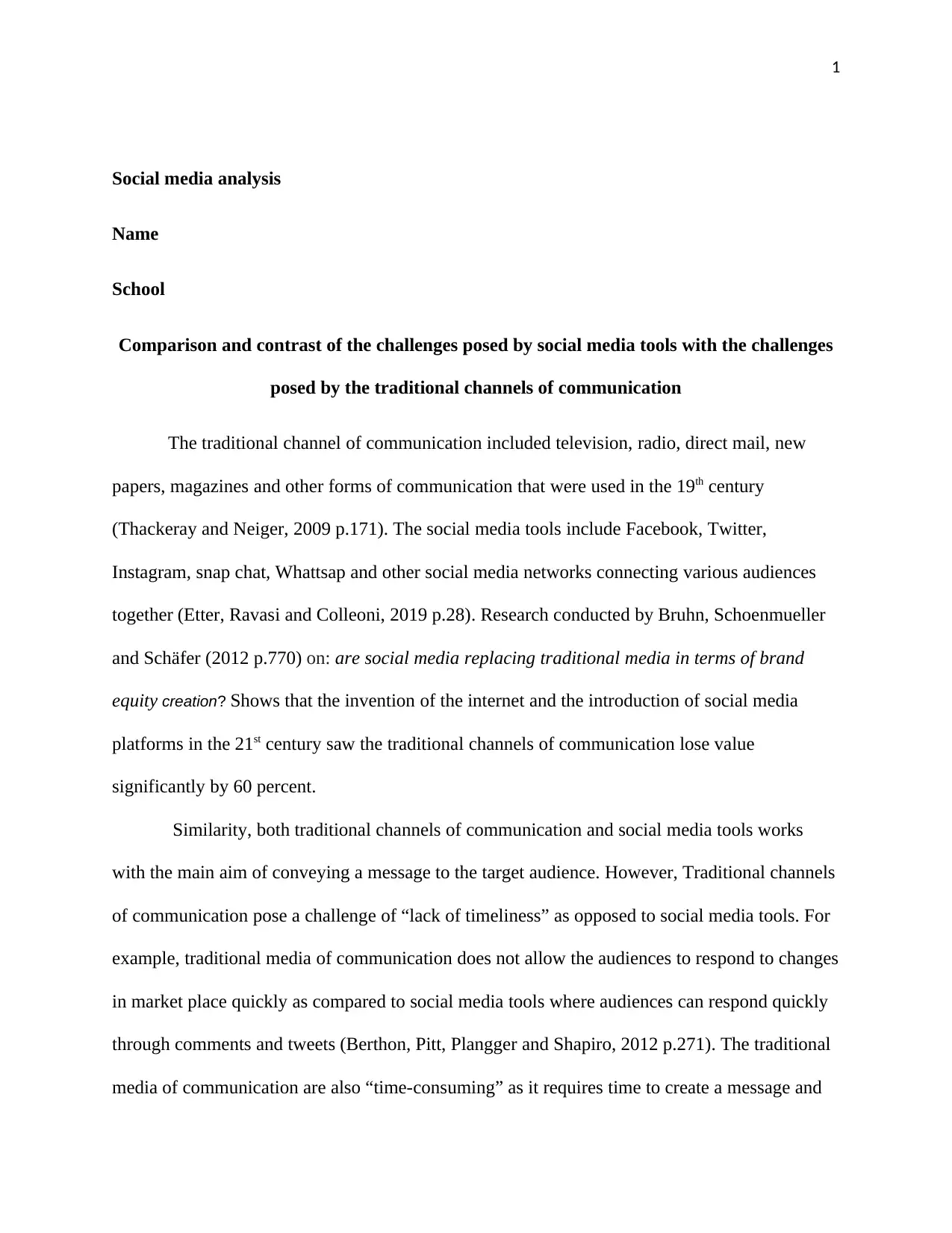
1
Social media analysis
Name
School
Comparison and contrast of the challenges posed by social media tools with the challenges
posed by the traditional channels of communication
The traditional channel of communication included television, radio, direct mail, new
papers, magazines and other forms of communication that were used in the 19th century
(Thackeray and Neiger, 2009 p.171). The social media tools include Facebook, Twitter,
Instagram, snap chat, Whattsap and other social media networks connecting various audiences
together (Etter, Ravasi and Colleoni, 2019 p.28). Research conducted by Bruhn, Schoenmueller
and Schäfer (2012 p.770) on: are social media replacing traditional media in terms of brand
equity creation? Shows that the invention of the internet and the introduction of social media
platforms in the 21st century saw the traditional channels of communication lose value
significantly by 60 percent.
Similarity, both traditional channels of communication and social media tools works
with the main aim of conveying a message to the target audience. However, Traditional channels
of communication pose a challenge of “lack of timeliness” as opposed to social media tools. For
example, traditional media of communication does not allow the audiences to respond to changes
in market place quickly as compared to social media tools where audiences can respond quickly
through comments and tweets (Berthon, Pitt, Plangger and Shapiro, 2012 p.271). The traditional
media of communication are also “time-consuming” as it requires time to create a message and
Social media analysis
Name
School
Comparison and contrast of the challenges posed by social media tools with the challenges
posed by the traditional channels of communication
The traditional channel of communication included television, radio, direct mail, new
papers, magazines and other forms of communication that were used in the 19th century
(Thackeray and Neiger, 2009 p.171). The social media tools include Facebook, Twitter,
Instagram, snap chat, Whattsap and other social media networks connecting various audiences
together (Etter, Ravasi and Colleoni, 2019 p.28). Research conducted by Bruhn, Schoenmueller
and Schäfer (2012 p.770) on: are social media replacing traditional media in terms of brand
equity creation? Shows that the invention of the internet and the introduction of social media
platforms in the 21st century saw the traditional channels of communication lose value
significantly by 60 percent.
Similarity, both traditional channels of communication and social media tools works
with the main aim of conveying a message to the target audience. However, Traditional channels
of communication pose a challenge of “lack of timeliness” as opposed to social media tools. For
example, traditional media of communication does not allow the audiences to respond to changes
in market place quickly as compared to social media tools where audiences can respond quickly
through comments and tweets (Berthon, Pitt, Plangger and Shapiro, 2012 p.271). The traditional
media of communication are also “time-consuming” as it requires time to create a message and
Secure Best Marks with AI Grader
Need help grading? Try our AI Grader for instant feedback on your assignments.
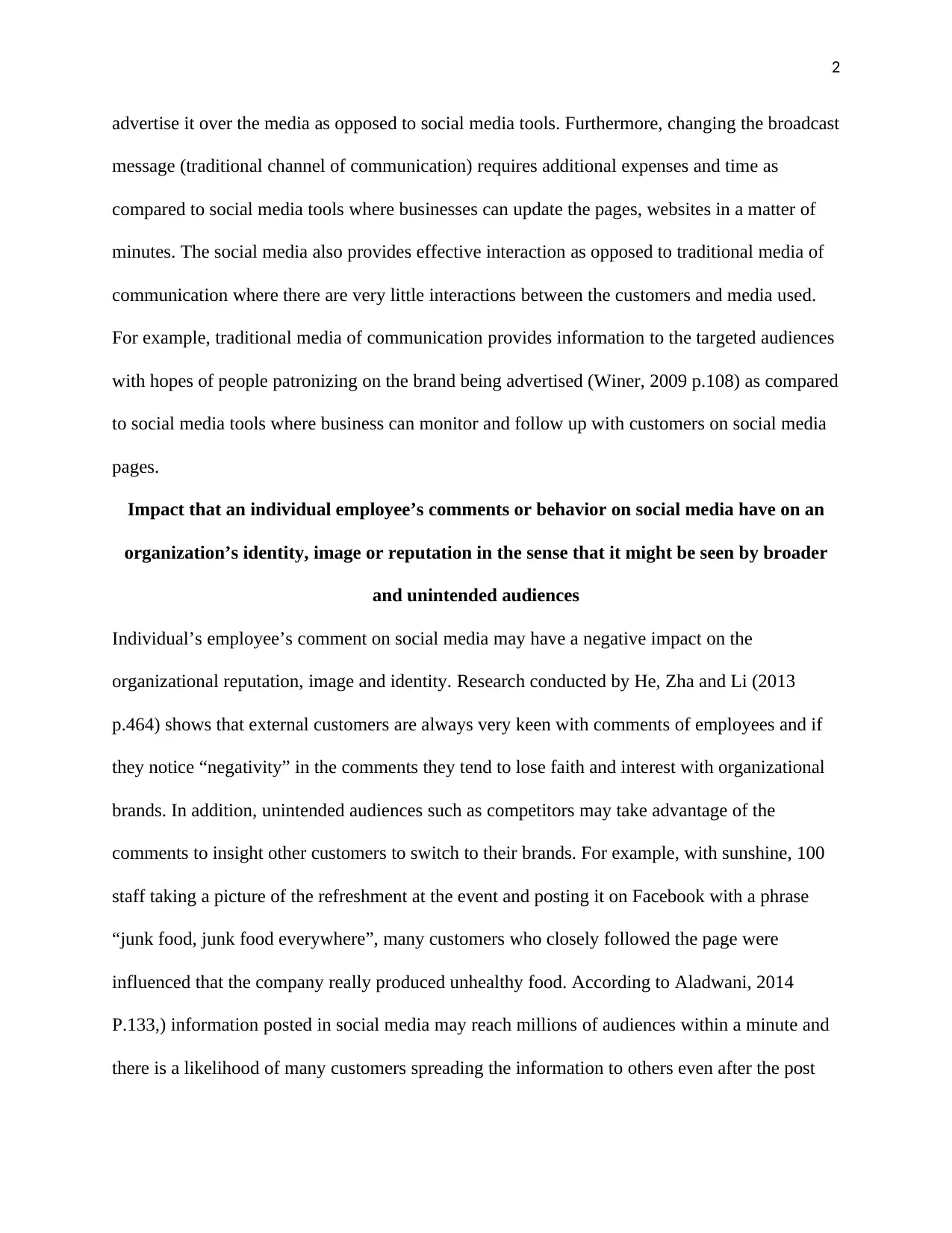
2
advertise it over the media as opposed to social media tools. Furthermore, changing the broadcast
message (traditional channel of communication) requires additional expenses and time as
compared to social media tools where businesses can update the pages, websites in a matter of
minutes. The social media also provides effective interaction as opposed to traditional media of
communication where there are very little interactions between the customers and media used.
For example, traditional media of communication provides information to the targeted audiences
with hopes of people patronizing on the brand being advertised (Winer, 2009 p.108) as compared
to social media tools where business can monitor and follow up with customers on social media
pages.
Impact that an individual employee’s comments or behavior on social media have on an
organization’s identity, image or reputation in the sense that it might be seen by broader
and unintended audiences
Individual’s employee’s comment on social media may have a negative impact on the
organizational reputation, image and identity. Research conducted by He, Zha and Li (2013
p.464) shows that external customers are always very keen with comments of employees and if
they notice “negativity” in the comments they tend to lose faith and interest with organizational
brands. In addition, unintended audiences such as competitors may take advantage of the
comments to insight other customers to switch to their brands. For example, with sunshine, 100
staff taking a picture of the refreshment at the event and posting it on Facebook with a phrase
“junk food, junk food everywhere”, many customers who closely followed the page were
influenced that the company really produced unhealthy food. According to Aladwani, 2014
P.133,) information posted in social media may reach millions of audiences within a minute and
there is a likelihood of many customers spreading the information to others even after the post
advertise it over the media as opposed to social media tools. Furthermore, changing the broadcast
message (traditional channel of communication) requires additional expenses and time as
compared to social media tools where businesses can update the pages, websites in a matter of
minutes. The social media also provides effective interaction as opposed to traditional media of
communication where there are very little interactions between the customers and media used.
For example, traditional media of communication provides information to the targeted audiences
with hopes of people patronizing on the brand being advertised (Winer, 2009 p.108) as compared
to social media tools where business can monitor and follow up with customers on social media
pages.
Impact that an individual employee’s comments or behavior on social media have on an
organization’s identity, image or reputation in the sense that it might be seen by broader
and unintended audiences
Individual’s employee’s comment on social media may have a negative impact on the
organizational reputation, image and identity. Research conducted by He, Zha and Li (2013
p.464) shows that external customers are always very keen with comments of employees and if
they notice “negativity” in the comments they tend to lose faith and interest with organizational
brands. In addition, unintended audiences such as competitors may take advantage of the
comments to insight other customers to switch to their brands. For example, with sunshine, 100
staff taking a picture of the refreshment at the event and posting it on Facebook with a phrase
“junk food, junk food everywhere”, many customers who closely followed the page were
influenced that the company really produced unhealthy food. According to Aladwani, 2014
P.133,) information posted in social media may reach millions of audiences within a minute and
there is a likelihood of many customers spreading the information to others even after the post
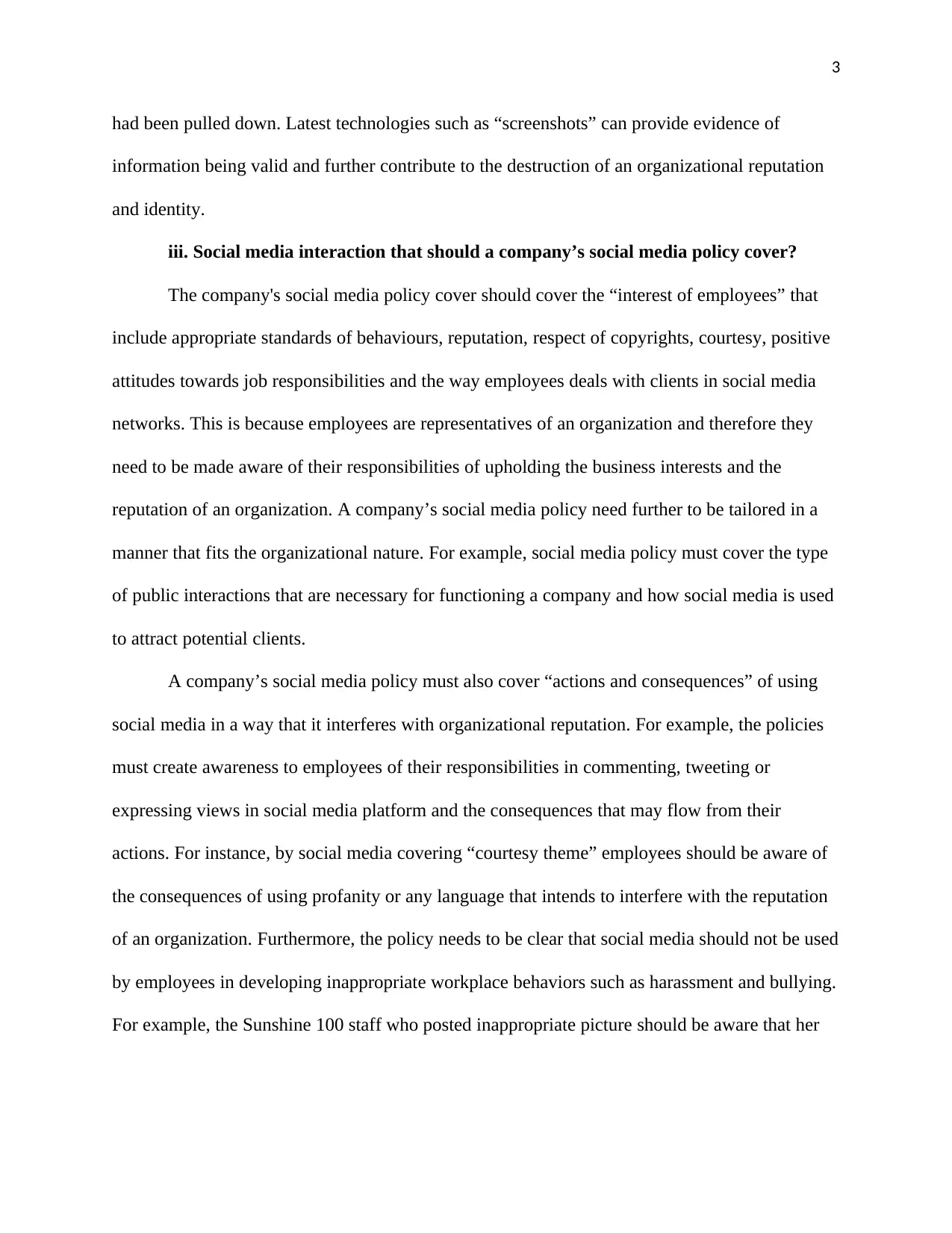
3
had been pulled down. Latest technologies such as “screenshots” can provide evidence of
information being valid and further contribute to the destruction of an organizational reputation
and identity.
iii. Social media interaction that should a company’s social media policy cover?
The company's social media policy cover should cover the “interest of employees” that
include appropriate standards of behaviours, reputation, respect of copyrights, courtesy, positive
attitudes towards job responsibilities and the way employees deals with clients in social media
networks. This is because employees are representatives of an organization and therefore they
need to be made aware of their responsibilities of upholding the business interests and the
reputation of an organization. A company’s social media policy need further to be tailored in a
manner that fits the organizational nature. For example, social media policy must cover the type
of public interactions that are necessary for functioning a company and how social media is used
to attract potential clients.
A company’s social media policy must also cover “actions and consequences” of using
social media in a way that it interferes with organizational reputation. For example, the policies
must create awareness to employees of their responsibilities in commenting, tweeting or
expressing views in social media platform and the consequences that may flow from their
actions. For instance, by social media covering “courtesy theme” employees should be aware of
the consequences of using profanity or any language that intends to interfere with the reputation
of an organization. Furthermore, the policy needs to be clear that social media should not be used
by employees in developing inappropriate workplace behaviors such as harassment and bullying.
For example, the Sunshine 100 staff who posted inappropriate picture should be aware that her
had been pulled down. Latest technologies such as “screenshots” can provide evidence of
information being valid and further contribute to the destruction of an organizational reputation
and identity.
iii. Social media interaction that should a company’s social media policy cover?
The company's social media policy cover should cover the “interest of employees” that
include appropriate standards of behaviours, reputation, respect of copyrights, courtesy, positive
attitudes towards job responsibilities and the way employees deals with clients in social media
networks. This is because employees are representatives of an organization and therefore they
need to be made aware of their responsibilities of upholding the business interests and the
reputation of an organization. A company’s social media policy need further to be tailored in a
manner that fits the organizational nature. For example, social media policy must cover the type
of public interactions that are necessary for functioning a company and how social media is used
to attract potential clients.
A company’s social media policy must also cover “actions and consequences” of using
social media in a way that it interferes with organizational reputation. For example, the policies
must create awareness to employees of their responsibilities in commenting, tweeting or
expressing views in social media platform and the consequences that may flow from their
actions. For instance, by social media covering “courtesy theme” employees should be aware of
the consequences of using profanity or any language that intends to interfere with the reputation
of an organization. Furthermore, the policy needs to be clear that social media should not be used
by employees in developing inappropriate workplace behaviors such as harassment and bullying.
For example, the Sunshine 100 staff who posted inappropriate picture should be aware that her
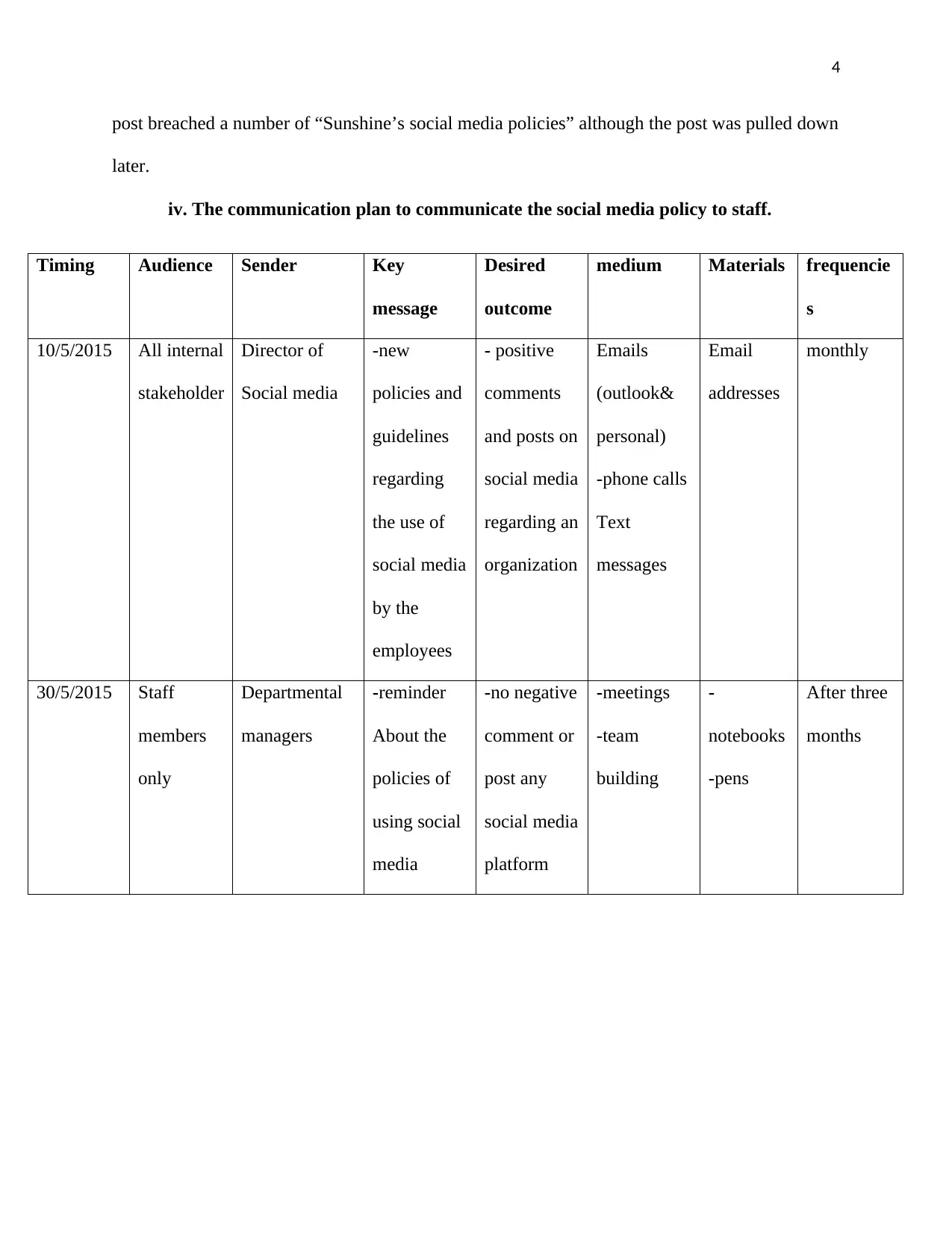
4
post breached a number of “Sunshine’s social media policies” although the post was pulled down
later.
iv. The communication plan to communicate the social media policy to staff.
Timing Audience Sender Key
message
Desired
outcome
medium Materials frequencie
s
10/5/2015 All internal
stakeholder
Director of
Social media
-new
policies and
guidelines
regarding
the use of
social media
by the
employees
- positive
comments
and posts on
social media
regarding an
organization
Emails
(outlook&
personal)
-phone calls
Text
messages
Email
addresses
monthly
30/5/2015 Staff
members
only
Departmental
managers
-reminder
About the
policies of
using social
media
-no negative
comment or
post any
social media
platform
-meetings
-team
building
-
notebooks
-pens
After three
months
post breached a number of “Sunshine’s social media policies” although the post was pulled down
later.
iv. The communication plan to communicate the social media policy to staff.
Timing Audience Sender Key
message
Desired
outcome
medium Materials frequencie
s
10/5/2015 All internal
stakeholder
Director of
Social media
-new
policies and
guidelines
regarding
the use of
social media
by the
employees
- positive
comments
and posts on
social media
regarding an
organization
Emails
(outlook&
personal)
-phone calls
Text
messages
addresses
monthly
30/5/2015 Staff
members
only
Departmental
managers
-reminder
About the
policies of
using social
media
-no negative
comment or
post any
social media
platform
-meetings
-team
building
-
notebooks
-pens
After three
months
Secure Best Marks with AI Grader
Need help grading? Try our AI Grader for instant feedback on your assignments.
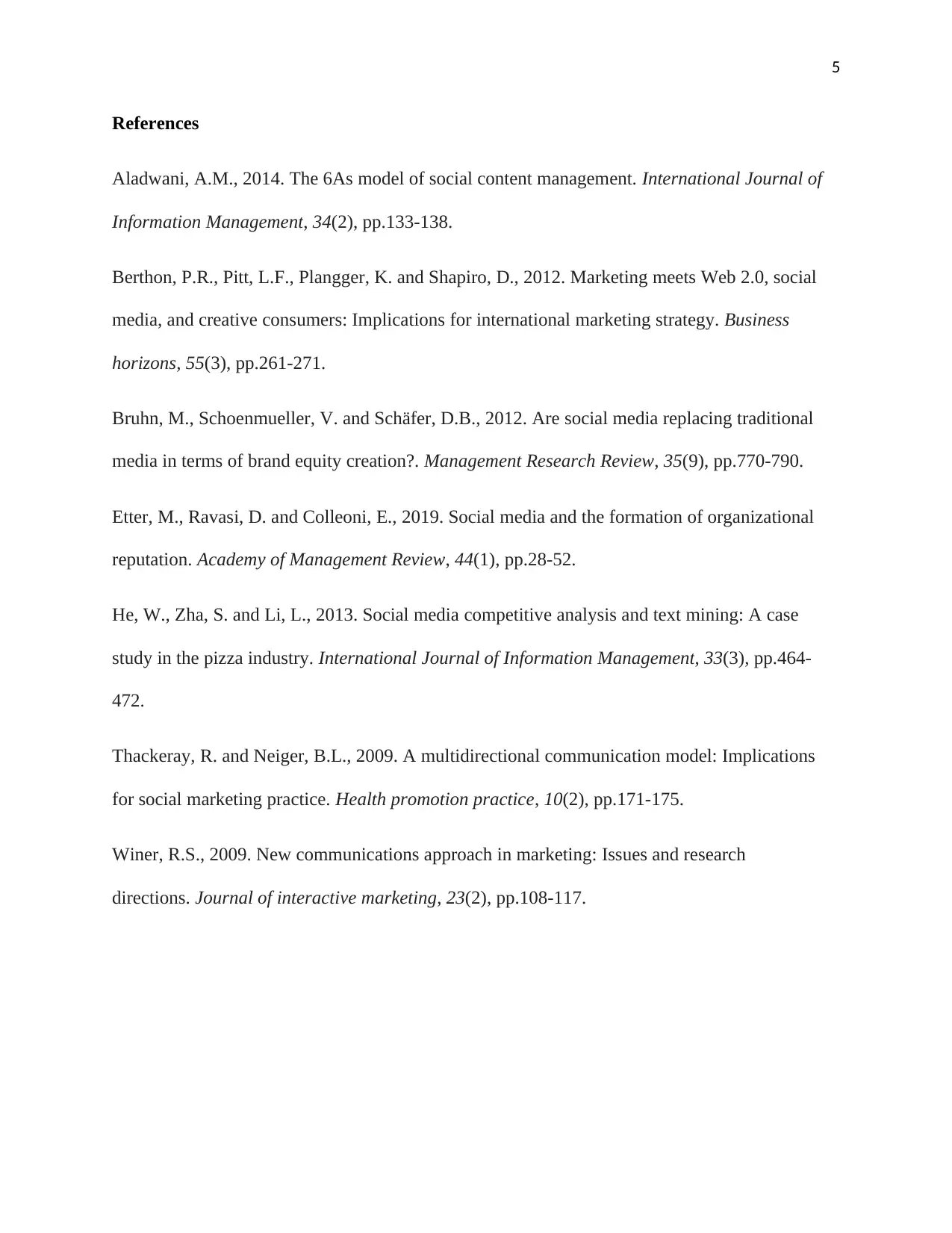
5
References
Aladwani, A.M., 2014. The 6As model of social content management. International Journal of
Information Management, 34(2), pp.133-138.
Berthon, P.R., Pitt, L.F., Plangger, K. and Shapiro, D., 2012. Marketing meets Web 2.0, social
media, and creative consumers: Implications for international marketing strategy. Business
horizons, 55(3), pp.261-271.
Bruhn, M., Schoenmueller, V. and Schäfer, D.B., 2012. Are social media replacing traditional
media in terms of brand equity creation?. Management Research Review, 35(9), pp.770-790.
Etter, M., Ravasi, D. and Colleoni, E., 2019. Social media and the formation of organizational
reputation. Academy of Management Review, 44(1), pp.28-52.
He, W., Zha, S. and Li, L., 2013. Social media competitive analysis and text mining: A case
study in the pizza industry. International Journal of Information Management, 33(3), pp.464-
472.
Thackeray, R. and Neiger, B.L., 2009. A multidirectional communication model: Implications
for social marketing practice. Health promotion practice, 10(2), pp.171-175.
Winer, R.S., 2009. New communications approach in marketing: Issues and research
directions. Journal of interactive marketing, 23(2), pp.108-117.
References
Aladwani, A.M., 2014. The 6As model of social content management. International Journal of
Information Management, 34(2), pp.133-138.
Berthon, P.R., Pitt, L.F., Plangger, K. and Shapiro, D., 2012. Marketing meets Web 2.0, social
media, and creative consumers: Implications for international marketing strategy. Business
horizons, 55(3), pp.261-271.
Bruhn, M., Schoenmueller, V. and Schäfer, D.B., 2012. Are social media replacing traditional
media in terms of brand equity creation?. Management Research Review, 35(9), pp.770-790.
Etter, M., Ravasi, D. and Colleoni, E., 2019. Social media and the formation of organizational
reputation. Academy of Management Review, 44(1), pp.28-52.
He, W., Zha, S. and Li, L., 2013. Social media competitive analysis and text mining: A case
study in the pizza industry. International Journal of Information Management, 33(3), pp.464-
472.
Thackeray, R. and Neiger, B.L., 2009. A multidirectional communication model: Implications
for social marketing practice. Health promotion practice, 10(2), pp.171-175.
Winer, R.S., 2009. New communications approach in marketing: Issues and research
directions. Journal of interactive marketing, 23(2), pp.108-117.
1 out of 5
Related Documents
Your All-in-One AI-Powered Toolkit for Academic Success.
+13062052269
info@desklib.com
Available 24*7 on WhatsApp / Email
![[object Object]](/_next/static/media/star-bottom.7253800d.svg)
Unlock your academic potential
© 2024 | Zucol Services PVT LTD | All rights reserved.





